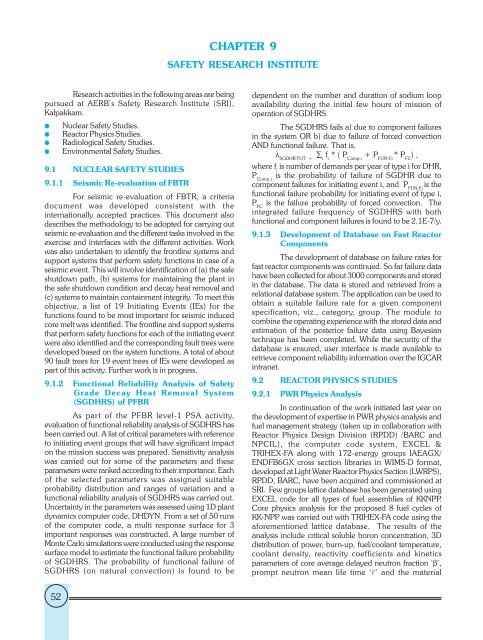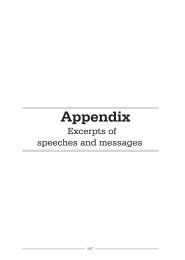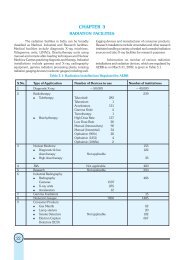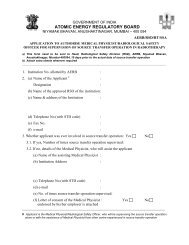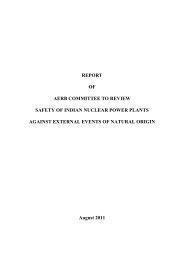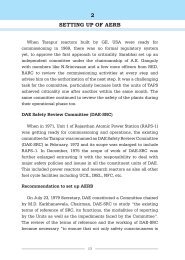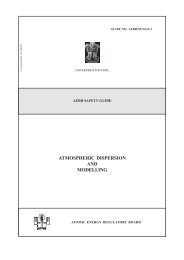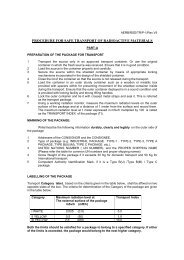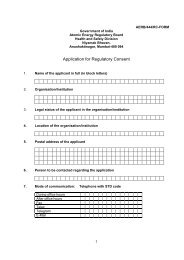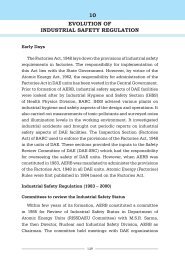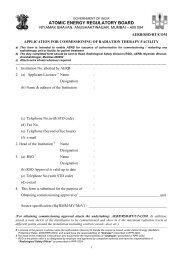here - Atomic Energy Regulatory Board
here - Atomic Energy Regulatory Board
here - Atomic Energy Regulatory Board
Create successful ePaper yourself
Turn your PDF publications into a flip-book with our unique Google optimized e-Paper software.
CHAPTER 9<br />
SAFETY RESEARCH INSTITUTE<br />
Research activities in the following areas are being<br />
pursued at AERB’s Safety Research Institute (SRI),<br />
Kalpakkam.<br />
l Nuclear Safety Studies.<br />
l Reactor Physics Studies.<br />
l Radiological Safety Studies.<br />
l Environmental Safety Studies.<br />
9.1 NUCLEAR SAFETY STUDIES<br />
9.1.1 Seismic Re-evaluation of FBTR<br />
For seismic re-evaluation of FBTR, a criteria<br />
document was developed consistent with the<br />
internationally accepted practices. This document also<br />
describes the methodology to be adopted for carrying out<br />
seismic re-evaluation and the different tasks involved in the<br />
exercise and interfaces with the different activities. Work<br />
was also undertaken to identify the frontline systems and<br />
support systems that perform safety functions in case of a<br />
seismic event. This will involve identification of (a) the safe<br />
shutdown path, (b) systems for maintaining the plant in<br />
the safe shutdown condition and decay heat removal and<br />
(c) systems to maintain containment integrity. To meet this<br />
objective, a list of 19 Initiating Events (IEs) for the<br />
functions found to be most important for seismic induced<br />
core melt was identified. The frontline and support systems<br />
that perform safety functions for each of the initiating event<br />
were also identified and the corresponding fault trees were<br />
developed based on the system functions. A total of about<br />
90 fault trees for 19 event trees of IEs were developed as<br />
part of this activity. Further work is in progress.<br />
9.1.2 Functional Reliability Analysis of Safety<br />
Grade Decay Heat Removal System<br />
(SGDHRS) of PFBR<br />
As part of the PFBR level-1 PSA activity,<br />
evaluation of functional reliability analysis of SGDHRS has<br />
been carried out. A list of critical parameters with reference<br />
to initiating event groups that will have significant impact<br />
on the mission success was prepared. Sensitivity analysis<br />
was carried out for some of the parameters and these<br />
parameters were ranked according to their importance. Each<br />
of the selected parameters was assigned suitable<br />
probability distribution and ranges of variation and a<br />
functional reliability analysis of SGDHRS was carried out.<br />
Uncertainty in the parameters was assessed using 1D plant<br />
dynamics computer code, DHDYN. From a set of 50 runs<br />
of the computer code, a multi response surface for 3<br />
important responses was constructed. A large number of<br />
Monte Carlo simulations were conducted using the response<br />
surface model to estimate the functional failure probability<br />
of SGDHRS. The probability of functional failure of<br />
SGDHRS (on natural convection) is found to be<br />
dependent on the number and duration of sodium loop<br />
availability during the initial few hours of mission of<br />
operation of SGDHRS.<br />
The SGDHRS fails a) due to component failures<br />
in the system OR b) due to failure of forced convection<br />
AND functional failure. That is,<br />
λ SGDHR-TOT =<br />
∑ i<br />
f i<br />
* ( P Comp,i<br />
+ P FUN-F,i<br />
* P FC<br />
) ,<br />
w<strong>here</strong> f i<br />
is number of demands per year of type i for DHR,<br />
P Comp,i<br />
is the probability of failure of SGDHR due to<br />
component failures for initiating event i, and P FUN-F,i<br />
is the<br />
functional failure probability for initiating event of type i,<br />
P FC<br />
is the failure probability of forced convection. The<br />
integrated failure frequency of SGDHRS with both<br />
functional and component failures is found to be 2.1E-7/y.<br />
9.1.3 Development of Database on Fast Reactor<br />
Components<br />
The development of database on failure rates for<br />
fast reactor components was continued. So far failure data<br />
have been collected for about 3000 components and stored<br />
in the database. The data is stored and retrieved from a<br />
relational database system. The application can be used to<br />
obtain a suitable failure rate for a given component<br />
specification, viz., category, group. The module to<br />
combine the operating experience with the stored data and<br />
estimation of the posterior failure data using Bayesian<br />
technique has been completed. While the security of the<br />
database is ensured, user interface is made available to<br />
retrieve component reliability information over the IGCAR<br />
intranet.<br />
9.2 REACTOR PHYSICS STUDIES<br />
9.2.1 PWR Physics Analysis<br />
In continuation of the work initiated last year on<br />
the development of expertise in PWR physics analysis and<br />
fuel management strategy (taken up in collaboration with<br />
Reactor Physics Design Division (RPDD) /BARC and<br />
NPCIL), the computer code system, EXCEL &<br />
TRIHEX-FA along with 172-energy groups IAEAGX/<br />
ENDFB6GX cross section libraries in WIMS-D format,<br />
developed at Light Water Reactor Physics Section (LWRPS),<br />
RPDD, BARC, have been acquired and commissioned at<br />
SRI. Few groups lattice database has been generated using<br />
EXCEL code for all types of fuel assemblies of KKNPP.<br />
Core physics analysis for the proposed 8 fuel cycles of<br />
KK-NPP was carried out with TRIHEX-FA code using the<br />
aforementioned lattice database. The results of the<br />
analysis include critical soluble boron concentration, 3D<br />
distribution of power, burn-up, fuel/coolant temperature,<br />
coolant density, reactivity coefficients and kinetics<br />
parameters of core average delayed neutron fraction ‘β’,<br />
prompt neutron mean life time ‘l’ and the material<br />
52


